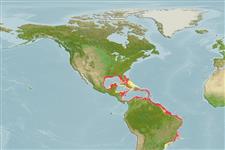Teleostei (teleosts) >
Eupercaria/misc (Various families in series Eupercaria) >
Haemulidae (Grunts) > Haemulinae
Etymology: Conodon: Latin, conicus = cone + Greek, odous = teeth (Ref. 45335).
More on author: Linnaeus.
Environment: milieu / climate zone / depth range / distribution range
Ecology
Marine; demersal; depth range 1 - 100 m (Ref. 9626). Subtropical; 30°N - 33°S, 99°W - 30°W
Western Atlantic: Texas and eastern Florida (USA) and Jamaica to Brazil. Including western Gulf of Mexico, Puerto Rico, Lesser Antilles, Central and South American coasts (Ref. 26938). Also found in Argentina (Ref. 86320).
Length at first maturity / Size / Weight / Age
Maturity: Lm 20.8 range ? - ? cm
Max length : 31.2 cm TL male/unsexed; (Ref. 127568); 35.4 cm TL (female); common length : 25.0 cm TL male/unsexed; (Ref. 5217); max. published weight: 411.20 g (Ref. 127568); max. published weight: 411.20 g
Found along sandy shores and over shallow muddy bottoms (Ref. 3798). Adults feed at night on crustaceans and small fishes (Ref. 3798). Marketed fresh (Ref. 3798).
Distinct pairing during breeding (Ref. 205).
Robins, C.R. and G.C. Ray, 1986. A field guide to Atlantic coast fishes of North America. Houghton Mifflin Company, Boston, U.S.A. 354 p. (Ref. 7251)
IUCN Red List Status (Ref. 130435)
Threat to humans
Harmless
Human uses
Fisheries: commercial; aquarium: public aquariums
More information
ReferencesAquacultureAquaculture profileStrainsGeneticsElectrophoresesHeritabilityDiseasesProcessingNutrientsMass conversion
Tools
Special reports
Download XML
Internet sources
Estimates based on models
Preferred temperature (Ref.
123201): 23.7 - 28, mean 26.7 °C (based on 408 cells).
Phylogenetic diversity index (Ref.
82804): PD
50 = 0.6250 [Uniqueness, from 0.5 = low to 2.0 = high].
Bayesian length-weight: a=0.01288 (0.01122 - 0.01480), b=3.00 (2.96 - 3.04), in cm total length, based on LWR estimates for this species (Ref.
93245).
Trophic level (Ref.
69278): 3.6 ±0.3 se; based on diet studies.
Generation time: 2.3 ( na - na) years. Estimated as median ln(3)/K based on 1
growth studies.
Resilience (Ref.
120179): Medium, minimum population doubling time 1.4 - 4.4 years (Assuming tm=2).
Fishing Vulnerability (Ref.
59153): Low to moderate vulnerability (27 of 100).
Climate Vulnerability (Ref.
125649): High vulnerability (55 of 100).
Nutrients (Ref.
124155): Calcium = 99.9 [20.7, 207.9] mg/100g; Iron = 1.2 [0.6, 2.3] mg/100g; Protein = 19.3 [17.4, 21.1] %; Omega3 = 0.376 [0.205, 0.643] g/100g; Selenium = 26.4 [14.2, 50.6] μg/100g; VitaminA = 12.3 [4.7, 30.6] μg/100g; Zinc = 0.766 [0.539, 1.125] mg/100g (wet weight);
